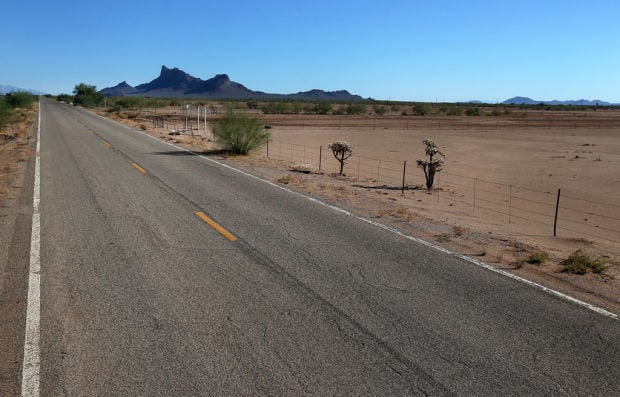Imagine a dust storm, driven by monsoon downbursts, building near the Maricopa-Pinal county line.
There are thousands of Interstate 10 motorists and hundreds of thousands of Phoenix exurb residents who would probably want to know about such a storm before the stinging, blinding wall of sand arrives.
But does all of metro Phoenix need to get the alert? Likely not, but the National Weather Service’s Ken Waters told the dozens of attendees at the annual dust-storm workshop in Coolidge last week that that’s exactly what would happen with the existing cellphone warning system in place for dust events.
“If I’m sitting in northwest Maricopa County and I’ve got a cellphone, I’m going to get that dust-storm warning, even though it’s 150 miles away,” he said. “That’s a dramatic over-warning.”
Come this fall, those warnings are slated to get much more focused, a development Waters described as “years and years in the making” and one of the most significant changes in the NWS’ warnings in recent memory.
Waters said the change wasn’t the result of new or improved technology, but rather the simple fact the agency didn’t apply the polygon warnings already in place for tornadoes, thunderstorms and other serious weather phenomena to dust events. But soon the warnings will reflect the fact that Arizona dust storms are in a league of their own.
So, starting this fall, if you get a dust warning on your cellphone, don’t brush it off like you might have in the past. Those alerts will then mean there is a dust storm nearby bearing down on you, and that change should help cut down on what Waters described as “warning fatigue.”
The Road Runner also heard some updates on the dust-sensor system the Arizona Department of Transportation has planned for a particularly problematic stretch of I-10 just northwest of Picacho Peak.
Let’s first talk about just how problematic the half-mile stretch between mile 213.6 and 214.1 is.
ADOT studied the matter between 2010 and 2015 and came up with some astonishing results. Over that period, there were 83 dust-related crashes — three with fatalities and five that resulted in incapacitating injuries — between East Riggs Road near Phoenix and West Ina Road near Tucson, an 87-mile stretch. More than half — 43, including two fatal incidents — occurred on the half-mile stretch in question, according to a presentation by ADOT system technology manager Reza Karimvand.
To improve safety in the corridor, ADOT intends to install a series of advanced short- and long-range dust sensors between mileposts 209 and 219 that connect to a series of electronic message boards and variable speed-limit signs that can warn drivers and reduce speed limits — as low as 35 mph — when dust storms or more localized dust events occur. Karimvand said the system will cost about $8 million, and the work is eligible for federal Highway Safety Improvement Program grants. The project, which is going to be rolled into the I-10-Arizona 87 interchange project, is expected to be advertised to bidders by mid-June.
But what is going on at this stretch that makes it so dangerous? There’s not an agreed-upon answer yet, but Karimvand was one of a number to point to agricultural-related activities near the interstate as a possibility.
On his way back to Tucson from the workshop, the Road Runner stopped at the area in question and saw acres of dusty land all but bereft of vegetation just a stone’s throw from the interstate.
In a wide-ranging, informal conversation toward the end of the dust summit, the Arizona Department of Environmental Quality’s Len Drago heard from scientists, county officials and private citizens who suggested a number of conceivable culprits and solutions. Several felt that heavy cattle grazing could be preventing native plants from returning to the denuded patch, and others pointed to the potential hydrological impacts of a canal that runs nearby.
Still others wanted to see data collected that could be used to establish legal liability for landowners whose property contributes to blowing dust and accidents, and another proposed looking into specialized conservation easements to cut down on grazing.
Whatever the root causes, Dan Leins, with the NWS’ Tucson office, told the group that localized dust events originating nearby — as opposed to massive haboobs that can travel for miles — are responsible for many, if not most, of the serious dust-related incidents.
Drago, the deputy director of ADEQ’s air-quality division, is part of an interagency work group tasked with learning about and addressing I-10 dust issues, including at this stretch. While he emphasized that a lot remains unknown about what’s going on at this half-mile, he said the group hopes to have some recommendations within the next couple months. The Road Runner already has his request in to see them when they’re ready.
As to root causes, “Once we identify that, then we’ll partner with the landowners to see if there are things we can do to help mitigate potential dust in the future,” he said, adding that so far the team has had “great cooperation” from those landowners.
DOWN THE ROAD
- From 9 a.m. to 7 p.m. Wednesday, South Craycroft Road will be closed at I-10 to allow for the installation of a construction bridge in preparation for I-10 deck work. All the on- and off-ramps will be open, but vehicles will not be able to pass under the interstate on Craycroft.
- There will be travel lane restrictions at the Speedway and North Stone Avenue intersection starting at 7 a.m. Monday to allow for utility work. Restrictions, which will not impact any turn lanes, will be in place through mid-afternoon Wednesday.





